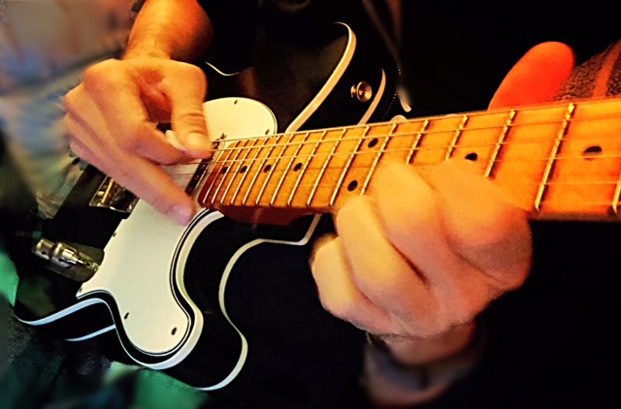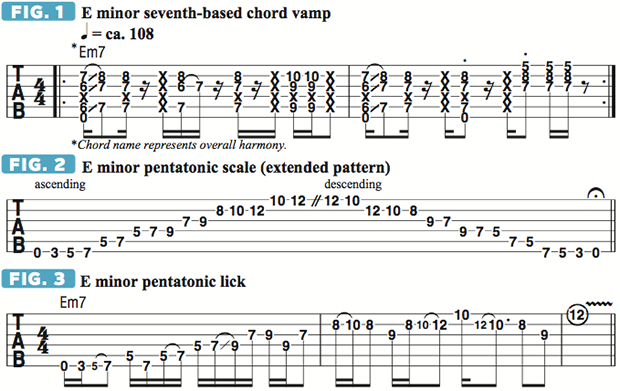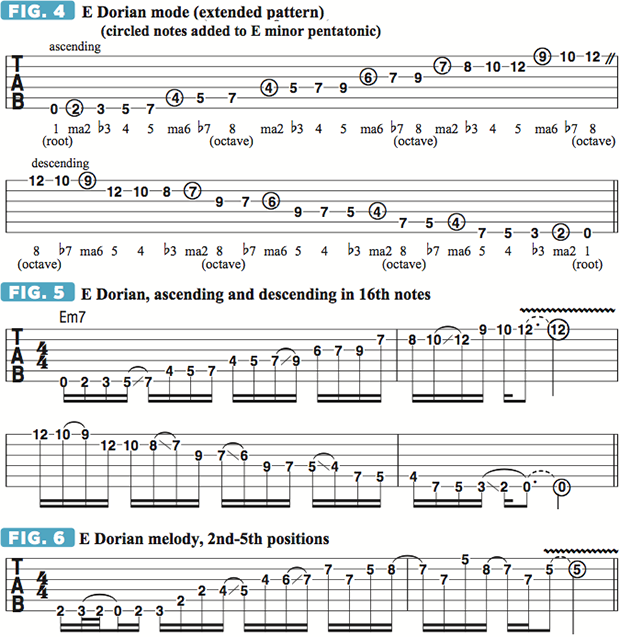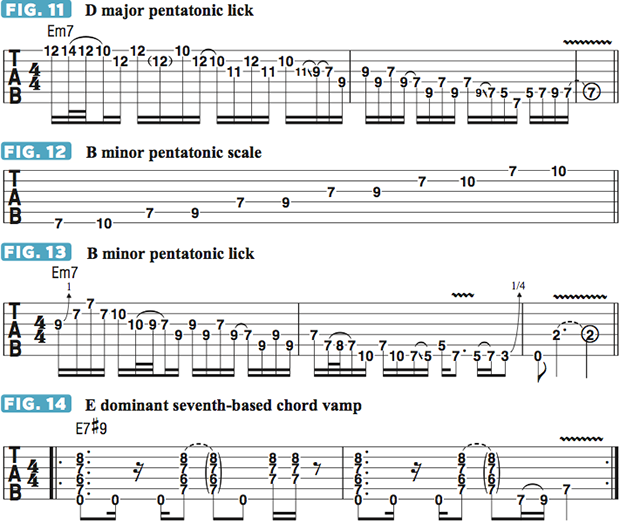Applying Modes to Improvised Guitar Solo Ideas, Part 1

Sooner or later, guitarists in every genre of music begin to wonder about the modes: what they are, how best to learn them and how to use them effectively when improvising.
In this edition of In Deep, we’ll take a look at the theoretical basis for the modes and cover a few useful ways to apply a modal approach to soloing over commonly used chord vamps.
The seven fundamental modes are a set of seven seven-note scales, all based on a “parent” major scale, with each mode beginning on a different note of that major scale and representing a different orientation of the seven notes around a different root note, or tonal center. Each mode comprises a specific sequence of half steps and whole steps that distinguish it from other modes and give it its unique sound and character.
The major scale is considered the “home” scale and is also known as the Ionian mode, followed by Dorian, Phrygian, Lydian, Mixolydian, Aeolian and Locrian, with each mode beginning on the next note of the home scale. A few of these modes are used much more prevalently than the others in popular musical styles, like rock, blues, pop, country, hard rock and metal.
For example, Dorian and Aeolian are the most widely used modes over minor-type chords, and the Mixolydian mode is used very commonly over both major and dominant seventh chords. When attempting to use a modal approach to improvisation, many musicians fall into the habit of always thinking of a mode in terms of its “major-scale equivalent.” For example, the E Mixolydian mode (E F# G# A B C# D) consists of the same seven notes as its parent A major scale (A B C# D E F# G#), so musicians will simply play A major scale–based ideas over E.
While this tactic will work and can be useful, it is ultimately a hindrance to understanding the individual musical characteristics of each mode and learning how to emphasize them for maximum musical effect. There are, however, a variety of different approaches to learning the modes and how to apply them in musically inventive ways, and this column will offer a few easily implemented approaches that will yield quick and effective results. Let’s start by laying down a basic funk- type groove that’s built around an Em7 chord (FIGURE 1). The scale used most prominently for soloing over a groove like this in rock and blues is minor pentatonic, theoretically spelled 1 b3 4 5 b7, and FIGURE 2 illustrates a useful extended fretboard pattern for the E minor pentatonic scale (E G A B D) that moves up and across the neck through three octaves.
Be sure to memorize this pattern. Once you have it down, proceed to FIGURE 3, which is a sample improvised melody based on this pattern and works well over the Em7 chord vamp shown in FIGURE 1. Notice the liberal use of finger slides and hammer-ons here and how they serve to provide a legato (smooth and connected) sound to the notes. As mentioned earlier, the Dorian and Aeolian modes are those used most often for soloing over minor- and minor seven–based chord vamps and progressions.
FIGURE 4 illustrates the E Dorian mode (E F# G A B C# D) played in an extended fretboard pattern that is based on the E minor pentatonic pattern we looked at a moment ago. E Dorian adds two notes to E minor pentatonic, the major second (2), F#, and the major sixth (6), C#. Play this mode repeatedly in ascending and descending manner while reciting (and memorizing) the names of the notes and their respective scale degrees—1 2 b3 4 5 6 b7. A great way to practice this extended E Dorian pattern is to play it up and down in 16th notes, as shown in FIGURE 5.
Feel free to add more hammer-ons, pull-offs and slides for a more legato sound. Now let’s use E Dorian to create some licks to play over our Em7 chord vamp. FIGURE 6 is a phrase that combines 16th notes and 32nd notes to move swiftly between the second and fifth positions.
In FIGURE 7, I use a rhythmically similar approach but begin in seventh position, gradually working my way down the fretboard to fourth position with an abundance of hammer-ons, pull-offs and finger slides used to connect scale positions. Now that we’re familiar with the sound and a useful fretboard pattern of E Dorian, let’s try alternatively using the “major-scale equivalency” approach described earlier. E Dorian is based on the parent D major scale (D E F# G A B C#), beginning on its second degree (E F# G A B C# D). While both scales comprise the same seven notes and are built from the same structure of half steps and whole steps, in D major is the root note, or "one," whereas in E Dorian E is the root, or "one."
FIGURE 8 illustrates the D major scale utilizing open strings. We’ll now use this same fretboard pattern to create an E Dorian melodic phrase over our Em7 chord vamp. Once again using 16th notes and 32nd notes, FIGURE 9 offers a “rolling” lick that incorporates open strings in order to facilitate unusual melodic shapes and rhythms. Living within the D major scale is the simpler, sparser D major pentatonic scale (D E F# A B), shown in FIGURE 10.
A cool and somewhat jazzy-sounding approach for soloing over Em7 is to play phrases based on D major pentatonic, as demonstrated in FIGURE 11. D major pentatonic’s relative minor scale is B minor pentatonic (B D E F# A), shown in FIGURE 12. FIGURE 13 offers a B minor pentatonic–based lick that works great over our Em7 vamp.
As a bonus, all of these licks work just as well over an E dominant seventh–type chord vamp, such as the one shown in FIGURE 14, due to our ears being conditioned to accept the minor third, in this case, G, as being a blue note when heard over a dominant seventh chord. Try them out, and then invent some of your own using these different approaches.
Part 1


Part 2


Get The Pick Newsletter
All the latest guitar news, interviews, lessons, reviews, deals and more, direct to your inbox!
Guitar World Associate Editor Andy Aledort is recognized worldwide for his vast contributions to guitar instruction, via his many best-selling instructional DVDs, transcription books and online lessons. Andy is a regular contributor to Guitar World and Truefire, and has toured with Dickey Betts of the Allman Brothers, as well as participating in several Jimi Hendrix Tribute Tours.










![Joe Bonamassa [left] wears a deep blue suit and polka-dotted shirt and plays his green refin Strat; the late Irish blues legend Rory Gallagher [right] screams and inflicts some punishment on his heavily worn number one Stratocaster.](https://cdn.mos.cms.futurecdn.net/cw28h7UBcTVfTLs7p7eiLe.jpg)
